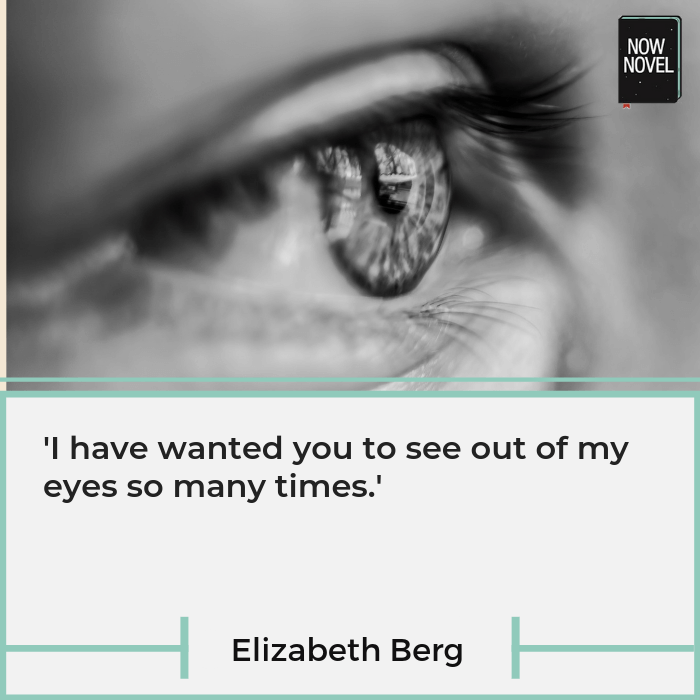The different points of view - first, second and third person POV - each offer creative ways to convey your characters' voices and personas. Read 5 tips with illustrative examples from novels:
First: POV definitions
Point of view, often abbreviated POV, is a crucial element of fiction writing. Ursula K. Le Guin gives a simple and clear definition of POV in her writing manual, Steering the Craft:
The technical term for describing who is telling the story and what their relation to the story is.
Ursula K. Le Guin, Steering the Craft (1998), p. 83.
The person telling the story, whose 'voice' we read it in, is called the 'viewpoint character'. In first-person POV, this is the narrator who says 'I'. In second-person point of view, the narrator says 'you'. An example of second-person POV:
You wake and everything has changed. You don't remember drinking heavily, but it feels as though you've blacked out. The room is dark and you bump your head as you grope the walls for a light switch.
Third-person point of view is one of the most common points of view. This is the narrator who describes characters actions using 'he', 'she', 'it', they, or a gender-neutral pronoun. For example:
It slowly lowers itself from the tree, slithering down the rough bark, before it slides away into the underbrush, on the hunt.
These types of narration have additional variations. In third person POV, the narration can be 'limited' or 'omniscient'. In 'limited' POV, we only read the thoughts and impressions of the character who is narrating. Other characters' minds and feelings can only be known through what the viewpoint character experiences or believes.
In 'omniscient' narration, the author/narrator is free to move between different character's viewpoints (the narrative isn't 'limited' to a fixed perspective; it's more like a fly on the wall).
Points of view examples and tips
Read these ideas of creative ways to use POV, with examples by well-known authors:
1: Use second person POV to make your reader the protagonist
Second-person POV is one of the least common in storytelling. Perhaps this is partly because second-person doesn't allow as much character psychology. This is because the reader imagines themselves performing each action instead of a separate character.
Although uncommon, and a little jarring to read at first for some, this POV is often fun, too. It creates a 'choose-your-own-adventure' effect, where the reader essentially becomes a character.
Italo Calvino uses this aspect of second-person POV masterfully in his mystery novel If on a winter's night a traveler (1979).
In this novel, you, the character/reader, purchase a book of the same title, only to find there are missing pages. You return the book to the store and you're sent on a wild goose chase trying to find the right book with the 'correct' story.
Here's an example of how Calvino uses second person to create suspense:
Here is page 31 again, page 32... and then what comes next? Page 17 all over again, a third time! What kind of book did they sell you, anyway? They bound together all these copies of the same signature, not another page in the whole book is any good.
You fling the book on the floor...
Calvino, If on a winter's night a traveler, p. 46
The second-person POV works because Calvino assigns you, the protagonist of the story, dramatic, surprising, and comical actions and discoveries. The familiar element of characters with 'real' psychology thus isn't missed. Because not knowing what 'you' will do or encounter next keeps you guessing.
[Use the 'Characters' section of Now Novel's story dashboard to outline detailed character profiles and build your story's cast.]

2: Write third person points of view with personality
Narrator's who use 'I' often endear themselves to us fast. Because the effect of the narration is to hear someone's experiences, views and emotions directly from them. The story reads as the character's most personal, private experience.
Charlotte Bronte's line 'Reader, I married him' in Jane Eyre is a good example of this effect.
Third person, however, can also create this intimacy. You can do this by:
- Using colourful language in narration that a character might use themselves (for example 'It was an effing travesty, and now there'd be all that malarkey for him to contend with')
- Focusing narration on subjects, ideas and images that would matter to the narrator (for example, an artist might refer to light, colour, the composition of a room)
Virginia Woolf is a master of describing characters' most private thoughts and feelings in third person. Here, in To the Lighthouse (1927), she describes Mrs. Ramsay's unease when her children are rude about her husband's friend, Tansley:
Strife, divisions, difference of opinion, prejudices twisted into the very fibre of being, oh that they should begin so early, Mrs. Ramsay deplored. They were so critical, her children. They talked such nonsense.
Woolf, To the Lighthouse (1927), p. 12.
Without Mrs Ramsay saying 'I' (she doesn't say 'I wish my children weren't so critical'), Woolf creates a strong sense of Ramsay's voice and values. She also shows Ramsay's disappointment in her children not upholding these values.
The way Woolf includes the interjection 'oh', a word that would usually be said out loud, in narration, makes this passage come across in Ramsay's voice.
The sentence structure towards the end, how Woolf adds 'her children' (almost as an afterthought) also creates the effect of a personal stream of thoughts and reflections from Ramsay's viewpoint.
3: Change points of view mid-scene
Changing points of view within a scene may jolt readers. Especially if you change from one type of narration to another (for example first-person to third-person narration). At worst, this simply has a confusing effect:
I get up in the dark and fumble for the light switch. He finally finds it, turns it on and it's blinding - there's no cover over the bulb. I quickly turn it off again.
Because the action involving the light switch is continuous, we can guess the same character performs the action throughout. But when the pronoun 'he' first appears, we think 'who is this?' because we expect the 'I', the first-person narrator, to remain the actor in the scene.
Where changing points of view mid-scene works is when changing between different third-person narrators.
Example of changing points of view mid-scene
Virginia Woolf does this in many of her novels. Ursula le Guin offers a caveat about this type of POV shift in Steering the Craft:
A writer must be aware of, have a reason for, and be in control of all shifts of viewpoint character.
Le Guin, Steering the Craft, p. 91.
Here's an example from To the Lighthouse. The Ramsays' young son James feels irritated by his father competing for attention:
James, as he stood stiff between her knees, felt her rise in a rosy-flowered fruit tree laid with leaves and dancing boughs into which the beak of brass, the arid scimitar of his father, the egotistical man, plunged and smote, demanding sympathy.
Filled with her words, like a child who drops off satisfied, he said, at last, looking at her with humble gratitude, restored, renewed, that he would take a turn [a walk - ed's note ...] He went.
Immediately, Mrs Ramsay seemed to fold herself together, one petal closed in another, and the whole fabric fell in exhaustion upon itself...'
Woolf, To the Lighthouse, p. 44.
In the space of one page, Woolf moves effortlessly from James' feelings (his anger at his father demanding his mother's attention), to Mr Ramsay's satisfaction at being reassured and his departure. From here, Woolf switches to Mrs Ramsay's POV, describing her exhaustion.
By giving different points of view in one scene, Woolf shows us the complex relationships between characters.
We can see in this small exchange James's protective and possessive nature towards his mother, Mr Ramsey's demanding need for emotional support, and Mrs Ramsay's exhaustion at having little space from these competing male needs.

4: Create the patterns of an individual voice
First person point of view enables us to filter characters' quirks into their narration.
Compare the cynical Holden Caulfield who narrates J.D. Salinger's Catcher in the Rye (1951) to the narrator Saleem in Salman Rushdie's Midnight's Children (1981).
Both books open with the first-person narrator sharing their backstory:
If you really want to hear about it, the first thing you’ll probably want to know is where I was born, and what my lousy childhood was like, and how my parents were occupied and all before they had me, and all that David Copperfield kind of crap, but I don’t feel like going into it, if you want to know the truth.
Salinger, The Catcher in the Rye, p.3.
Compare the voice of the disaffected teen (including angsty descriptive words such as 'lousy') with Saleem Sinai in Midnight's Children:
I was born in the city of Bombay ... once upon a time. No, that won't do, there's no getting away from the date. I was born in Doctor Narlikar's Nursing Home on August 15th, 1947. And the time? The time matters, too. Well then: at night. No, it's important to be more ... On the stroke of midnight, as a matter of fact.
Rushdie, Midnight's Children, p. 3.
When you write in first-person POV, read examples such as the two above. How does Salinger create an angry teen viewpoint character? With forceful slang ('lousy', 'crap') and his implied rejection of authority and how he 'should' tell a story (his rejection of 'David Copperfield kind of crap'.)
Rushdie, in contrast, creates his thoughtful, gifted character by using speech patterns - pauses - to show him as a character who takes pains to find the right words. The two narrators are clearly distinct.
Similarly, use elements such as word choice, grammar and sentence structure to make your first person narrator's reflect their age, environment and outlook.
5: Switch points of views between chapters well
Although authors like Woolf are skilled at changing viewpoint characters within a single scene, it's more common to change POV between chapters or sections.
There are multiple ways to do this. One way to show the reader that a different character is narrating is simply to title each chapter with its narrator's name.
William Faulkner does this in his poignant novella, As I Lay Dying (1930). Each character in the Bundren family (along with several secondary characters) narrates a chapter.
You can also do as Gabriel Garcia Marquez in Love in the Time of Cholera (1985) and simply signal a shift of viewpoint character with the wording of your new chapter's first sentence.
Fermina Daza's husband has died. She spies a former suitor, Florentino Ariza, who has come to the wake to pay his respects. Florentino is the viewpoint character when the next chapter begins. Here is the tail end of Fermina's chapter, followed by the viewpoint change:
Only then did she realize that she had slept a long time without dying, sobbing in her sleep, and that while she slept, sobbing, she had thought more about Florentino Ariza than about her dead husband.
*
Florentino Ariza, on the other hand, had not stopped thinking of her for a single moment since Fermina Daza had rejected him out of hand after a long and troubled love affair fifty-one years, nine months, and four days ago.Marquez, Love in the Time of Cholera, pp. 51-53.
It's clear who the focal character is with the change in chapter. The moment Marquez chooses to shift between the two points of view is brilliant because we see how both characters react to a reunion long in the making.
For a definitive look at using point of view, including the newly recognized fourth point of view, read our guide. An in-depth look at fourth person point of view is also available. Struggle with character description? Get our workbook How to Write Real Characters: Character description for practical tips and exercises to write memorable description.









